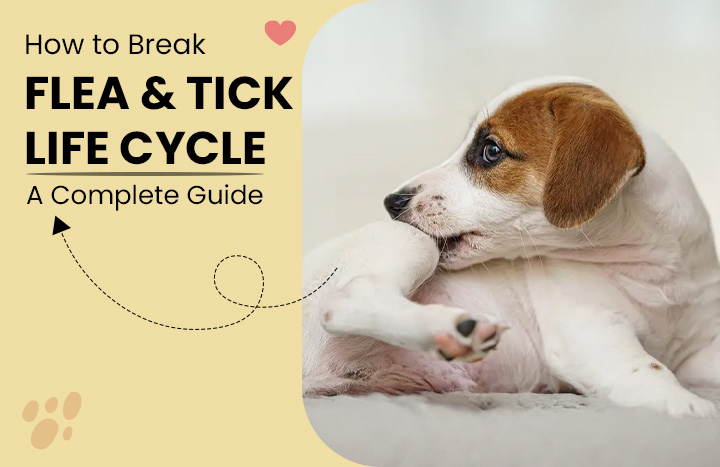
Both dogs and cats are prone to flea and tick infestations. The pesky parasites take shelter in our furry babies’ bodies and cause them serious discomfort and harmful vector-borne diseases. The organisms multiply quickly, making it very difficult for pet parents to eradicate them. Therefore, breaking their life cycle is immensely crucial to control their breeding and ensure the safety of our furry companion. In this blog, we will take you through the detailed process of how to break flea and tick life cycles in order to protect our pets. Let’s get started.
Understanding the Life Cycle of Fleas and Ticks
Let’s take a brief look at the life cycle of fleas and ticks.
Flea Life Cycle
Fleas undergo a complete metamorphosis during their four distinct life stages, which are egg, larva, pupa, and adult.
Egg
Female fleas lay eggs after consuming a blood meal, usually on the pet or other areas where the host rests, such as carpets, bedding, and cracks in flooring. A female flea can produce between 40 and 800 eggs over her brief lifespan. Flea eggs typically hatch in 2 to 14 days, depending on the warmth and humidity they receive.
Larva
Upon hatching, the larvae feed on organic matter like adult flea feces, dried excrement, and dead skin, which provides them with essential nutrition for development. The larva takes about 8 to 24 days to develop. When ready, larvae spin silk cocoons and enter the pupa stage. They attach debris and dirt to camouflage and protect themselves till their transformation into the next stage.
Pupa
In this stage, the flea develops its physical structures and turns into an adult. This stage usually lasts a week, provided they receive favorable conditions. However, if the conditions are not in favor, the stage can even last a year.
Adult
Once turned into an adult, the flea feeds on the blood of its host. After feeding, mating occurs quickly, and the cycle begins again with the laying of eggs. Adult fleas can remain alive anywhere from several weeks up to a year, depending on the species and their access to hosts.
Tick Life Cycle
The life cycle of ticks consists of four main stages: egg, larva, nymph, and adult.
Egg
Upon receiving a proper blood meal, an adult female tick mates with an adult male tick. The parasite then lays eggs in a warm and sheltered environment. The eggs take 2 weeks to 2 months to hatch into six-legged larvae.
Larva
After hatching, the larva seeks a host to attach to. Once attached to the host, the larva feeds on its blood and undergoes multiple stages of molting before transforming into a nymph.
Nymph
After receiving the required blood meal from the host, the larva develops 8 legs. It molts for around 2 weeks before transferring into a nymph. The nymph then looks for a host to attach to and feed.
Adult
Once the tick reaches its adult stage, it becomes sexually mature and ready to reproduce. In this stage, it looks for larger animals to host to feed and mate. Females feed longer and lay thousands of eggs before dying. Males typically die after mating.
How to Break Flea and Tick Life Cycles?
The following are some of the effective ways to help you break the life cycle of fleas and ticks and ensure the well-being of your pets.
- Treat your pets with year-round flea and tick preventives formulated to kill adult and immature stages of the parasites. They also prevent future infestations.
- Vacuum your carpets, furniture and pet bedding regularly to eliminate any eggs, larvae and pupae.
- Wash pet bedding frequently in hot water with a pet-friendly disinfectant liquid to kill the eggs and larvae hiding inside it.
- Keep a careful watch on your pet and monitor it daily for fleas and ticks, especially after its outdoor activities.
- Use a flea comb on your pet regularly to remove any adult fleas and flea dirt.
- If you have a yard, keep it clean and well-maintained. Mow the grass, trim bushes and eliminate leaf litter and debris to prevent flea and tick infestation.
- Take the help of pet-friendly environmental treatment products to treat flea and tick infestations in your outdoor areas.
Frequently Asked Questions
- Does environmental cleaning matter?
Yes, environmental cleaning is crucial to break the flea and tick life cycle. Vacuuming carpets, washing pet bedding in hot water, and cleaning furniture can help remove eggs, larvae, and pupae from the environment.
- Where are flea eggs found?
Flea eggs are found not only on pets but also in surrounding areas like bedding, carpets, furniture, clothing, and even outdoor areas like porches and yards where pets frequent. Eggs easily fall off pets into these environments.
- How do treatments break the flea life cycle?
Effective flea preventives kill adult fleas and many also kill immature stages like eggs and larvae on the pet. Treating pets year-round with oral or spot-on preventives helps prevent infestations.
- What are the best flea and tick preventives on the market?
The best flea and tick preventives on the market are as follows:
Dogs
– Simparica Trio
– NexGard Chewables
– Bravecto Chew
– NexGard Spectra
– Frontline Plus for Dogs
Cats
– Frontline Plus for Cats
– Credelio
– Capstar (flea only)
– Selehold (no ticks)
– Advantage Multi (no ticks)
Ending Note
To break the flea and tick life cycle effectively, it is crucial that you adopt a consistent and comprehensive approach that targets all stages of these parasites. Always remember that persistence and cleanliness, along with vigilant treatment, can break the reproductive cycle of fleas and ticks and help safeguard your pet as well as your home.
At DiscountPetMart, we carry a wide range of flea and tick preventives at the best prices. Check out our online store to enjoy lucrative deals on your preferred treatments and a whole lot of other pet essentials.

